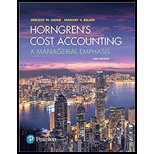
Concept explainers
Budgeting, ethics, pharmaceutical company. Chris Jackson was recently promoted to Controller of Research and Development (R&D) for BrisCor, a Fortune 500 pharmaceutical company that manufactures prescription drugs and nutritional supplements. The company’s total R&D cost for 2017 was expected (budgeted) to be $5 billion. During the company’s midyear budget review, Chris realized that current R&D expenditures were already at $3.5 billion, nearly 40% above the midyear target. At this current rate of expenditure, the R&D division was on track to exceed its total year-end budget by $2 billion!
In a meeting with CFO Ronald Meece later that day, Jackson delivered the bad news. Meece was both shocked and outraged that the R&D spending had gotten out of control. Meece wasn’t any more understanding when Jackson revealed that the excess cost was entirely related to research and development of a new drug, Vyacon, which was expected to go to market next year. The new drug would result in large profits for BrisCor, if the product could be approved by year-end.
Meece had already announced his expectations of third-quarter earnings to Wall Street analysts. If the R&D expenditures weren’t reduced by the end of the third quarter, Meece was certain that the targets he had announced publicly would be missed and the company’s stock price would tumble. Meece instructed Jackson to make up the budget shortfall by the end of the third quarter using “whatever means necessary.”
Jackson was new to the controller’s position and wanted to make sure that Meece’s orders were followed. Jackson came up with the following ideas for making the third-quarter budgeted targets:
- a. Stop all research and development efforts on the drug Vyacon until after year-end. This change would delay the drug going to market by at least 6 months. It is possible that in the meantime a BrisCor competitor could make it to market with a similar drug.
- b. Sell off rights to the drug Martek. The company had not planned on doing this because, under current market conditions, it would get less than fair value. It would, however, result in a one-time gain that could offset the budget shortfall. Of course, all future profits from Martek would be lost.
- c. Capitalize some of the company’s R&D expenditures, reducing R&D expense on the income statement. This transaction would not be in accordance with GAAP, but Jackson thought it was justifiable because the Vyacon drug was going to market early next year. Jackson would argue that capitalizing R&D costs this year and expensing them next year would better match revenues and expenses.
- 1. Referring to the “Standards of Ethical Behavior for Practitioners of
Management Accounting andFinancial Management ,” Figure 1-7 (page 17),which of the preceding items (a–c) are acceptable to use? Which are unacceptable?
Required
- 2. What would you recommend Jackson do?
Want to see the full answer?
Check out a sample textbook solution
Chapter 1 Solutions
EBK HORNGREN'S COST ACCOUNTING
- Recently, Abercrombie & Fitch has been implementing a turnaround strategy since its sales had been falling for the past few years (11% decrease in 2014, 8% in 2015, and just 3% in 2016.) One part of Abercrombie's new strategy has been to abandon its logo-adorned merchandise, replacing it with a subtler look. Abercrombie wrote down $20.6 million of inventory, including logo-adorned merchandise, during the year ending January 30, 2016. Some of this inventory dated back to late 2013. The write-down was net of the amount it would be able to recover selling the inventory at a discount. The write-down is significant; Abercrombie's reported net income after this write-down was $35.6 million.Interestingly, Abercrombie excluded the inventory write-down from its non-GAAP income measures presented to investors; GAAP earnings were also included in the same report. Question: What does "write-down" mean?arrow_forwardHi expert please give me answer general accounting questionarrow_forwardCan you please solve this questions final answerarrow_forward

 AccountingAccountingISBN:9781337272094Author:WARREN, Carl S., Reeve, James M., Duchac, Jonathan E.Publisher:Cengage Learning,
AccountingAccountingISBN:9781337272094Author:WARREN, Carl S., Reeve, James M., Duchac, Jonathan E.Publisher:Cengage Learning, Accounting Information SystemsAccountingISBN:9781337619202Author:Hall, James A.Publisher:Cengage Learning,
Accounting Information SystemsAccountingISBN:9781337619202Author:Hall, James A.Publisher:Cengage Learning, Horngren's Cost Accounting: A Managerial Emphasis...AccountingISBN:9780134475585Author:Srikant M. Datar, Madhav V. RajanPublisher:PEARSON
Horngren's Cost Accounting: A Managerial Emphasis...AccountingISBN:9780134475585Author:Srikant M. Datar, Madhav V. RajanPublisher:PEARSON Intermediate AccountingAccountingISBN:9781259722660Author:J. David Spiceland, Mark W. Nelson, Wayne M ThomasPublisher:McGraw-Hill Education
Intermediate AccountingAccountingISBN:9781259722660Author:J. David Spiceland, Mark W. Nelson, Wayne M ThomasPublisher:McGraw-Hill Education Financial and Managerial AccountingAccountingISBN:9781259726705Author:John J Wild, Ken W. Shaw, Barbara Chiappetta Fundamental Accounting PrinciplesPublisher:McGraw-Hill Education
Financial and Managerial AccountingAccountingISBN:9781259726705Author:John J Wild, Ken W. Shaw, Barbara Chiappetta Fundamental Accounting PrinciplesPublisher:McGraw-Hill Education





